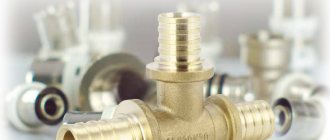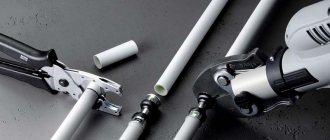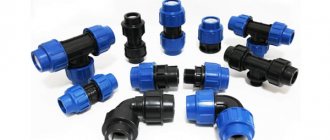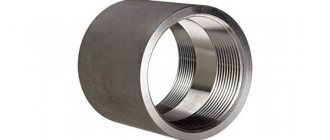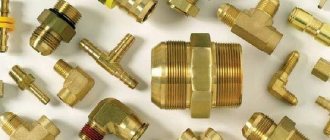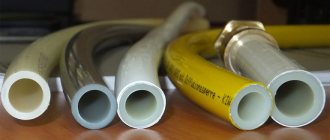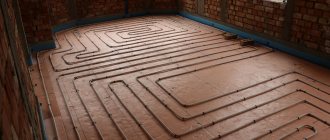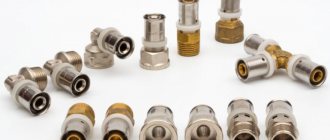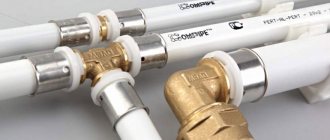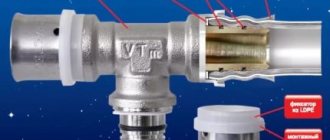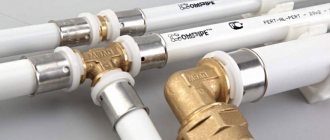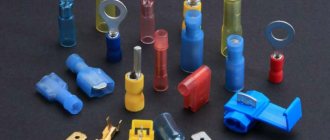Metal-plastic pipes are widely used when laying hot water supply and heating lines to supply coolant to heat exchange radiators and laying underfloor heating circuits. When installing them, the main tool is press pliers for metal-plastic pipes, widely represented on the domestic market by different manufacturers and models.
It is worth noting that the cost of the press tool for metal-plastic is designed for use by both ordinary users and professional installers. When choosing press pliers, it is useful to study their types, technical characteristics, equipment and functionality - many devices allow you to crimp pipes made of various materials.
Rice. 1 PEX-AL-PEX pipes - sectional view and fitting installation
Press fittings what are they?
There are several types of press fittings, however, they are practically the same.
Any part is constructed from: You can find out the price and buy heating equipment and related products from us. Write, call and come to one of the stores in your city. Delivery throughout the Russian Federation and CIS countries.
- Cases. The type of device depends on this element; it can be made in the form of an angle, tee or coupling. The most common materials used for the body are brass or copper.
- Shells. This is the basic component of the fitting, which is made of stainless steel. The pads of a special tool designed for crimping are mounted on the surface of the sleeve.
- Clips. This piece looks like a ring made of elastic material. The clip is designed to connect the sleeve and the body, and also acts as a gasket that protects the connection from the spread of galvanic currents.
Valtec one-piece press fitting device
Advantages
The bar for the mixer is polypropylene.
The nozzles can have both internal and external threads. Thanks to the unified dimensions, it is possible to connect metal-plastic parts to the copper sections of the mains. Provided that the fittings are installed correctly, it is possible to ensure a very high-quality permanent connection. It is distinguished by its mechanical strength (at the joining points, the working pressure easily reaches 10 atm without any risk to the part). Long-term use of the fitting is another advantage.
Manufacturers most often provide a 50-year guarantee, but only if all manipulations with the product comply with technological standards. The compression fitting is better than other designs also because it does not require mandatory supervision and maintenance. This is very good when hidden lines are installed or concrete is poured. Such connections do not lose their practical advantages even with thermal expansion. Therefore, they can be safely used even in heating systems and in DHW circuits; this will not cause any problems for the consumer.
The installation itself is easy and quick, eliminating the need to master specific tools or special training. Such manipulations are accessible even to beginners; the only tools they will need are crimping pliers. By using fittings, you can reduce the total number of pipes and additional fittings. Therefore, the total costs of installing a water supply or heating system are lower. The general coincidence of the terms of use of the fitting and the metal-plastic pipeline allows them to synchronize their repair and replacement.
Even where there is a very strong corrosive environment, press fittings are guaranteed to withstand. They retain this property throughout the entire operational period. The developers were able to achieve their optimal use for the circulation of both cold and very hot (by domestic standards) water.
Press pliers for metal-plastic pipes - types and popular brands
All press tools for crimping fittings are produced with three types of drives - manual, electric and hydraulic; pneumatic models can also be found on the market, but they are intended for use in stationary production conditions.
Below we consider the technical and operational parameters of the tool supplied to the retail chain for pressing pipe fittings and some popular models.
Manual
Manual mechanical tools for press fittings are produced in a mini design, incomplete or standard; typical crimping pliers have the following features:
- Designed for crimping metal-plastic PEX pipes with a diameter of 16, 20, 26 and 32 mm. On many even professional tools (Rems, Henco), the latter standard size is not crimped due to the requirement for too much physical effort.
- The manual press for crimping fittings is equipped with replaceable jaws of various sizes; it is mainly used for crimping PEX pipes only.
- Many manufacturers produce tools to increase the applied force with telescopic or thread-extendable sliding handles.
- Hand tools can be equipped with both replaceable jaws and all-metal heads of established standard sizes (Rems brand).
Rice. 7 Manual press pliers for metal-plastic pipes - appearance and equipment
- A manual press for metal-plastic pipes is suitable for one-time installation or repair of a pipeline; its professional use is irrational (for a slightly higher price you can purchase hydraulic tools).
- The disadvantages of hand tools include their large size and the inconvenience of working in conditions of limited access to the object.
- Hand pliers are produced in different price categories, their cost ranges from 6,000 (Valtec) to 65,000 rubles. (Henco brand).
Installation technology
| Types of installation | Technology | Peculiarities |
| Compression installation | After preparing the pipes of the required size, threaded connecting nuts and a split ring are put on their ends, after which the fitting is inserted. Using a wrench, the connection is secured. | Suitable for supplying buildings with cold and hot water, as well as for heating systems. |
| Installation using special press fittings. | A ring-shaped press sleeve is attached to the end of the pipe. An expander is then inserted into the pipe to increase the diameter to the required size in order to push the pipe onto the fitting all the way. A press sleeve is placed on top of the connection, due to which, after a certain period of time, the pipe returns to its original shape before expansion and tightly compresses the fitting. | High strength connection that forms a seamless monolithic connection. It will not be possible to dismantle for subsequent installation of the pipeline system. |
| Installation using electric welding. | A welding coupling is put on the cut with terminals to which a welding machine is connected, with the help of which the pipe and coupling are heated to 170°C. After cooling, a seam forms. | A welded connection requires special equipment and at least basic welding skills. Suitable for pipes with operating pressure up to 12 atm. |
7 tips on which cross-linked polyethylene pipes for underfloor heating, heating and water supply are best to choose
General description of couplings for crimping
A press fitting connection is one of the most reliable methods of joining metal-plastic pipes. As a result of this installation, the pipeline turns out to be one-piece, but very reliable. If after assembly you need to change its circuit, you will have to redo a lot from scratch, but leaks are practically excluded.
The reliability of the press connection is ensured by crimping the pipe around the fitting fitting with a special stainless steel sleeve. If the pipe needs to be replaced, the pressed section will need to be cut out
Press fittings are a permanent type of connection, obtained in this case by compressing a metal sleeve around an o-ring. In this case, as a result of the crimping performed, the ring is irreversibly deformed. It cannot be removed and then reused. The geometry of the pipe itself also changes slightly.
For metal-plastic pipes, fittings for crimping are made from:
- brass;
- of stainless steel.
The first option is more preferable. It is more reliable and durable in conditions of high humidity.
Unscrupulous manufacturers often use aluminum and other soft metals to make the fittings in question. They can be easily identified by weight. Brass is obviously heavier in the hands than these fakes. It is strictly not recommended to use such products for crimping metal-plastic pipes. By definition, they are not able to tightly compress the fitting and pipe plastic.
Fittings for press connections and metal-plastic pipes for installation of intra-house pipeline systems should be taken from the same manufacturer, otherwise you can forget about the absolute reliability of the joint
Each manufacturer of metal-plastic pipes recommends purchasing its own set of press fittings. And for good reason. Pipe products and fittings from different manufacturers can vary in diameter by literally a millimeter. Quite a bit, but this is enough to reduce the reliability of the connection. It’s better not to save money here, risking a break and leakage.
There is no single standard for the outlines and exact dimensions of fittings. Each manufacturer independently selects these parameters for their products. Some sellers offer universal press fittings, but this is a banal advertising ploy. The use of such connecting parts is inevitable and will result in leaks in the near future after installation.
Installation
Review of plastic ball valves for polyethylene PVC and HDPE pipes
Fittings made from the material in question can be of different shapes. Popular are corners (bends), plugs, crosses, tees.
Based on the installation principle, we can distinguish compression fittings for cross-linked polyethylene and press fittings. They can make detachable and permanent connections, respectively.
Have you decided to use cross-linked polyethylene as the main material when installing your heating system? Then fittings and pipes should be used from the same manufacturer. Otherwise, products from different manufacturers may not be suitable for each other. And although you may not notice the difference at first glance, leaks may appear during operation.
Installing compression fittings
It is worth saying that these elements are a collapsible structure. To prevent leaks from occurring, the plastic liner is compressed using the union nut.
Installation of compression fittings is carried out without special equipment as follows:
- First, you need to cut the edge of the pipe by at least 5 cm. This is done because the pipe end made of SP may lose some of its performance properties during long-term storage.
- You can cut the product with a grinder or a simple hacksaw for metal. The cutting line must be perpendicular to the longitudinal axis of the pipe. The end needs to be chamfered, which will make it easier to install the water supply. There should be no hangnails. If necessary, you can use sandpaper to remove rough edges.
- A union nut and sleeve are installed on the pipe, and sometimes a backup seal ring is also used. The ring is mounted at the end of the connection segment.
- Now the pipe is inserted into the fitting and the union nut is attached. To ensure a tight seal, it will be enough to tighten everything by hand. If necessary, you can take an adjustable wrench, but in this case do not use excessive force.
Compression fitting for PEX pipes 20x2.0x3/4 STOUT
Installation of press fittings
Such products are installed a little differently. Press fittings imply permanent connections that are characterized by high strength and long service life. Therefore, they can be used when installing high pressure systems.
Expansion Tool for PEX Pipe
Installation is carried out in stages:
- First, the pipes are prepared. The same as when installing compression type fittings.
- An uncut sleeve is attached to the pipe.
- To install, you need to make the pipe edges a little wider. This can be done using a special expander and the necessary attachment.
- The expander handles are brought together and secured in this position for a couple of seconds.
- Then the device is taken out, and the connection fitting is placed in the pipe. Since the material is elastic, the SP pipe tends to take its previous shape and tightly compresses the surface of the fitting - and after a short time it is almost impossible to remove the element.
- The sleeve takes up its working position - it moves onto the pipe above the connecting fitting of the fitting.
- At the final stage, the sleeve is crimped using special press equipment.
Press fitting tee Valtec
https://youtube.com/watch?v=XhNKqi2-tHM
As you have seen, installing cross-linked polyethylene fittings in any case is not difficult, so even a beginner can do it.
Professionals advise when purchasing fittings and pipes made of cross-linked polyethylene to consider the Rehau company. The products from this manufacturer are high quality and have a long service life. However, products from other popular manufacturers are often not inferior in quality characteristics, and some models may cost you even less.
Cross-linked polyethylene is currently the best material for laying water pipes, and compression fittings are the best solution for good sealing of pipe joints. Compared to other products, copper or plastic, the SP system is characterized by high quality and practicality in installation. The high price for fittings for cross-linked polyethylene quickly pays off with resistance to wear and a long service life.
Possibilities of modern press jaws
In the field of installation of heating systems, polymer pipelines made of cross-linked polyethylene PEX, polypropylene PP with additional shells made of aluminum Al (fiberglass in PP) have long replaced steel pipes from use in this area.
However, metal has returned to heating systems in a different form and currently thin-walled pipes made of galvanized steel, stainless steel and copper are replacing plastic in the European market due to a number of significant advantages.
First of all, metal pipelines are environmentally friendly, are not subject to significant linear expansion, are oxygen-tight and have a significant service life, and thanks to the latest technologies they are easy to install.
To join them, no welding or threading is required; press pliers with special attachments are sufficient.
In the domestic market for installation services, the installation of thin-walled, corrosion-resistant pipelines can be afforded by customers with high incomes - the cost of such pipes is an order of magnitude higher than their polymer analogues.
Rice. 4 Types of press jaws
It is worth noting that modern tools for press fittings are produced in multifunctional models with replaceable crimping jaws or heads designed to work with various types of pipe materials. Standard pliers may include standardized attachments with different profile sections of replaceable press jaws, the letter designations of which are deciphered as follows:
- TN - crimp for pipes made of PEX-Al-PEX metal plastic with typical outer diameters of 16, 20, 26 (25) and 32 mm.
- U – profile for working with PEX-Al-PEX metal plastic; some users use a nozzle for crimping copper pipelines if the kit does not include special V profile jaws. Designed for crimping pipes with a circumference of 16, 20, 25, 32 mm.
- V – nozzle for crimping European-made copper and stainless steel pipes of sizes 15, 18, 22 and 28 mm.
- M – profile for crimping copper and stainless steel tubes made in China, South Korea and Europe with a circumference of 12, 15, 18, 22 and 28 mm.
- VUS is a crimp for pressing pipes produced in the USA and Canada in sizes 1/2, 3/4 and 1 inch.
- VAU is a profile for Australian-made copper and stainless steel pipes with diameters of 20 and 25 mm.
Above were the types and sizes of replacement jaws for modern high-quality hand and hydraulic tools.
In almost all electric and electro-hydraulic professional models, the maximum pressing threshold is a pipe diameter of 108 mm.
Rice. 5 Appearance of press jaws for hydraulic pliers
Press-on method
The most correct method for installing cross-linked plastic pipes, which takes full advantage of the material’s qualities such as flexibility and molecular memory. When working, put a sleeve on the pipe and press the fitting into the pipe hole.
The connection is distinguished by the highest degree of sealing, in contrast to the methods discussed above, and ensures high reliability of the pipeline. The technology consists of flaring the pipe edge, after which a compression-type fitting is inserted into it. It is fastened using a metal sleeve, which is pulled from above onto the pipe at the location of the fitting.
Rice. 9 Compression method of connecting PE-X pipes
Technology for crimping pipes with hand pliers
Pressing sleeves onto fittings of metal-plastic pipes using hand pliers is carried out in the following order:
- First, the required applied force is measured against the diameter of the fitting sleeve. If it is large, the handles are extended by threaded connection of additional fragments or by extending them in telescopic models. Sponges of a suitable outer diameter are inserted into the pliers.
- All pipes made of polymer materials are made according to the outer size, so their inner diameter may differ within millimeters. Since the fittings inserted inside the pipe shell have a standard outer size, the inner walls of the pipe are adjusted to fit them using the mandatory use of a calibrator. Using a manual or automatic device, the pipe is expanded from the inside to the size of the fitting being inserted.
- Next, push the pipe into the fitting to the very end; the signal will be a click or its appearance in one or more windows, which are present in many fitting models.
To ensure that the pipe is completely immersed in the sleeve in the absence of windows, a corresponding mark can be applied to its surface shell with a pencil along the length of the sleeve.
- Next, place the pliers on the sleeve and bring the handles together; after a click or full contact, the crimping is considered complete.
Rice. 17 Sequence of crimping operations
The main method of installing popular metal-plastic pipelines is to connect them with fittings using the crimping method using special press pliers. The retail network offers a wide range of devices with manual, electric, hydraulic or electro-hydraulic drives, designed for both domestic use and constant professional use by highly qualified installers. The price of press pliers for metal-plastic pipes ranges from 4,000 rubles. for manual hydraulic models made in China, purchased on the Aliexpress resource, up to a cost of 160,000 rubles for American electro-hydraulic devices of the Ridgid brand.
How to choose a good fitting and install it
The markings on the case will tell a lot to the connoisseur. Those companies that make high-quality docking elements simply will not use cheap printed fixtures. Therefore, any inscription, even a single symbol, is printed clearly and expressively, excluding the slightest vagueness or misinterpretation
It is equally important to evaluate the weight of the structures, since normal fittings are made from selected brass. If someone tries to claim that lightweight products are just as valuable, this is just a clever marketing ploy or some kind of misunderstanding
It is worth taking a closer look at the appearance of the fitting. If it is made of a thin layer of metal, it will not be possible to obtain a reliable joint. Professionals confidently say that by purchasing cheap elements from small retail outlets, especially those operating unofficially, people doom themselves to re-laying the pipeline. In this regard, investing in a high-quality and expensive variety of components is more than justified.
Using a gauge, the ovality that inevitably occurs during the cut is corrected. Following this, the inside is chamfered using a chamfer remover or a sharp knife. If you use a simple knife, you will still have to refine the desired area with sandpaper. Only when all this has been done can you thread the fitting onto the pipe, making sure to check whether it is seated tightly. There are models that do not require fastening of crimp couplings. Then these same couplings are placed on the pipe and a fitting is inserted into the part, on top of which sealing rings are fixed. At the points of contact between a metal-plastic pipe and a metal element, an insulating gasket is required to protect against electrochemical corrosion.
When connecting fittings of various designs, the sleeve is captured in a clamp and brought together until the handles stop. When the work is done well, the metal part becomes arched, and the fitting receives a pair of identical strips in the shape of a ring. Processing must be completed in one go. The crimping should not be repeated. This will only cause damage to the connection, so the defect will be irreversible. Therefore, you should prepare for work carefully and take into account all the smallest nuances, freeing up time so that nothing interferes.
Such connections, if done properly, can be of no less quality than when using welding - and their tightness satisfies all requirements. It is recommended to use fittings of the same brand as the pipes being connected. If the choice has not yet been made, you can safely use designs from Henko, Valtec. The products of these concerns are of high quality and are very popular. It is easy to use such parts even for beginners.
The fitting for a steel pipeline does not have a fitting; it is just a sleeve itself, which is crimped with pliers. An attempt to compress a metal-plastic pipe without a softening “intermediary” will end in its deformation.
In the next video you will see the principle of working with press fittings for Valtec stainless pipes.
Cutter and pipe cutter for metal-plastic pipes
For products of small and medium diameter, a cutter for metal-plastic pipes is used. This tool, compared to scissors, is more suitable for professional use, which does not exclude use at home.
Even at home, special scissors or a cutter should be used to cut pipes
It is equipped with comfortable handles and a latch that locks the closed position. The support and top brackets allow you to set the required girth of the pipe and the perpendicular direction of the removable knife. Using a cutter makes the use of a calibrator unnecessary; it is equipped with built-in calibrators. The cutter can not only cut the structure, but also restore its shape at the cut.
To cut large-diameter metal-plastic pipes, it is recommended to use a pipe cutter. Using a pipe cutter requires attention to a number of details:
- is it suitable for cutting products of a given diameter;
- what the tool manufacturer recommends regarding the frequency of knife sharpening;
- what material was used to make the knife.
What tool can be used
The selection of special pliers includes both the simplest manual and more powerful hydraulic models. At home, when it is necessary to install or repair a pipeline only occasionally, the functionality of a manual design is quite sufficient. In terms of the quality of the joint created, if everything is done correctly and carefully, there will be no difference from professional devices
It is important to consider that all models are optimized for a specific diameter. There are tools that come with inserts
Then a lot depends on what set of inserts are supplied. Along with the simplest press tongs, there are also more advanced designs. So, if a tool is marked with the letters APC, this means that the device automatically monitors the reliability of the joint being formed. It is impossible to open the press until crimping is completed. The APS marking indicates that the pliers can not only adapt to different sizes of fittings, but also distribute the applied forces most accurately. But if OPS is written on the pliers, then the tool is equipped with stepped clamps and is therefore capable of multiplying the applied force.
Secrets of proper installation of such parts
Installation of parts is very quick and quite simple. To do this, you will need a special tool, without which crimping the fitting is impossible.
How to choose press pliers?
Press pliers for fittings are a device designed for installing a part onto a pipe. Manual models and more complex hydraulic ones are available. For independent work, the first option is quite suitable, since it is the easiest to use and cheapest. And the quality of connections made with its help is not inferior to those in the process of which a professional hydraulic tool was used.
When purchasing equipment, you need to consider that it is designed to work with a certain pipe diameter. There are models equipped with special liners that make it possible to work alternately with pipes of several diameters. In addition, improved variations of the instrument can be found on sale. They have a special marking:
- OPS - the device increases the forces applied to it by using step-type clamps.
- APC – during the process, automatic control of its quality is carried out. The press will not open until crimping is completed successfully.
APS - the device independently distributes the force that is applied to it, depending on the size of the fitting.
Crimping pliers are a tool necessary for installing fittings. Manual and hydraulic models of special equipment are available
What to look for when purchasing connectors
The reliability of the connection largely depends on the quality of the parts. When purchasing press fittings, experts advise paying attention to the following points:
- Quality of markings on the body . Companies that produce quality parts do not use cheap molds. All symbols on the fitting body are printed very clearly.
- Part weight . To produce high-quality products, brass is used, which is quite heavy. It is better to avoid fittings that are too light.
- Appearance of the element . Low-quality parts are made of thin metal that looks like aluminum. It is not able to provide a quality connection.
You should not skimp on fittings and try to buy them “cheaply” at a dubious retail outlet. In this case, there is a high probability of subsequent reworking of the entire pipeline.
Advantages of press fittings
By performing the correct installation of press fittings, you will receive reliable connections that have the following advantages:
- high strength: able to withstand pressure up to 10 atm.;
- long service life: if all installation and operation rules are followed, such connections can last 40-50 years without replacement;
- the connections do not need to be monitored or maintained, so they are well suited for installation when laying hidden pipelines;
- fittings tolerate temperature changes well;
- There are no difficulties during installation;
- These connecting elements are resistant to corrosion.
Straight press fitting
